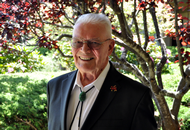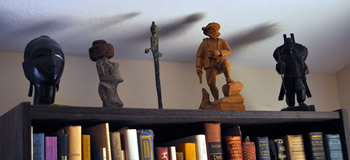From Phonetics to Sci Fi to the First TQ: Dr. Francis Cartier
by Tomiko Breland
 Dr. Francis Cartier has stories. He has stories within stories, and stories built on top of stories—and nearly all of them are based on (or in the neighborhood of) the English language. Many of them, actually, are rooted in English for specific purposes, something he was practicing years before it was recognized as a legitimate field in English language teaching. Now retired, Dr. Cartier was a longtime member of TESOL and one of the initial members of the association; indeed, he recalls with fondness the way it took nearly a year to settle on the organization’s name; many involved were fierce with their opinions because they cared so much. Though there were four or five other groups at the time, Dr. Cartier remembers that everyone wanted to be a part of TESOL: The group was new, but it soon became the group to be in.
Dr. Francis Cartier has stories. He has stories within stories, and stories built on top of stories—and nearly all of them are based on (or in the neighborhood of) the English language. Many of them, actually, are rooted in English for specific purposes, something he was practicing years before it was recognized as a legitimate field in English language teaching. Now retired, Dr. Cartier was a longtime member of TESOL and one of the initial members of the association; indeed, he recalls with fondness the way it took nearly a year to settle on the organization’s name; many involved were fierce with their opinions because they cared so much. Though there were four or five other groups at the time, Dr. Cartier remembers that everyone wanted to be a part of TESOL: The group was new, but it soon became the group to be in.
He tells the beginning of this story over email, when he reaches out to TESOL to offer up his hard copy of the very first issue of TESOL Quarterly (TQ), the association’s flagship journal. He had no idea that TESOL had long been missing—and seeking—this very issue, the only one missing from its archives. Indeed, TESOL had in the last year put out a call for the issue, one that Dr. Cartier hadn’t seen. The lucky coincidence of his scaling down his personal library and TESOL’s search for the infamous first issue of TQ led to, luckily for me, a meeting.
We meet for lunch in the quaint ocean town of Pacific Grove, in California, USA, a beautiful little haven with no highway access on the Monterey Bay Peninsula, brimming with colorful historic homes and charming bed and breakfasts. I know that Dr. Cartier is in his nineties, but I would not have guessed this upon meeting him. He’s dressed in a dark gray suit jacket and crisp white shirt (what my mother would have called “smart”), a bolo clasped with a shiny jade ornament, and a red pin that looks like a dragon gleaming on his lapel (though he later tells me it is an English lion). As we pass through his retirement community, several ladies smile and tell him he looks dapper.
I’m a little nervous; Dr. Cartier boasts an impressive CV. He’s a doctor of speech pathology, a former editor for several academic journals and professor and director of multiple language programs, and a past president of the Mensa Education & Research Foundation (for which he still writes a regular column).
We sit and I become acutely aware of my posture, perhaps because Dr. Cartier’s is superb; this is no surprise when I learn that he was a soldier. Before the war (he refers to World War II always as “the war”), he’d been a radio announcer and radio playwright, but, as he says, “I talked myself into it, and before I knew it I was a bombardier.”
After the war, the Air Force paid for Dr. Cartier’s education, and he was burdened with the decision of what field to pursue. At the University of Southern California, he began in the Drama Department, which was a subdivision of the Speech Program, to become an actor. He was required to take some speech science courses (phonetics, mechanics of speech, etc.). The science pulled at him, though, and he ended up with a PhD in speech pathology—a far cry from the theater work he’d once aspired to.
A lifelong career with the military began when Dr. Cartier was recruited from his teaching position at the University of Florida to write textbooks for the Air Force. In 1947, leading into World War II, the Army Air Corps was becoming the Air Force, and they needed new materials. Dr. Cartier cowrote Introduction to the Air Force, in which he was responsible for the technical vocabulary section for recruits who might not know the terms they needed—“about how planes fly” (or aerodynamics).
When I ask him what he knew during this time about English for specific purposes (ESP), he waves it off with his hand, “It was an incipient field back then.” However, he’s being modest. ESP as a field wouldn’t show up for nearly two more decades, “emerging out of Halliday, MacIntosh, and Strevens’ (1964) groundbreaking work” (Hyland, 2007, p. 391).
And yet, in the late 40s and throughout the 50s, Dr. Cartier was applying many of today’s ESP principles (needs analysis, ethnography, discourse analysis) to his work. He leans over his plate of spaghetti and meatballs and says, “Back then, people who didn’t speak English in universities weren’t helped—their instructors didn’t know how to help them.” He tells me the following story to illustrate his point.
In the mid-50s, Dr. Cartier was sent by the Air Force to the University of Puerto Rico to address an issue. (He was a fixer. If there was a language problem anywhere in the world on a base, they sent him to figure out what it was and address it.) Entire classes were graduating from the Reserve Officers’ Training Corps (ROTC) unable to speak comprehensible English. The instructors had been letting the students speak Spanish in class and then they had just lumped all of these graduates into Spanish-speaking units in the Air Force, but this was less than desirable and not optimal for communication. “They could read English but they couldn’t speak—it was all phonetics!” he said (a little gleefully). Phonetics is something Dr. Cartier has plenty of experience in, luckily: His first textbook was titled The Phonetic Alphabet, he considers himself a phonetician, and even his past training to become a stage actor at the University of Southern California would come in handy (hours of practicing various accents in front of a mirror, deliberate noticing of pronunciation). He conducted research on technical Air Force terms (wing, propeller, pilot) and on the phonetics of the local context, studying the dialect in the city and even on the university campus. He came up with a glossary of words that had to be properly pronounced for successful Air Force communication and wrote out the glossary using the International Phonetic Alphabet. The first word he put on the glossary was adjective—a purposeful challenge, because it used several sounds/phonemes that were difficult for Spanish speakers. Apparently, he was practicing in the field of ESP before it even existed.
* * *
Dr. Cartier’s home is small and neat and crowded with little statuettes, trinkets, and mementos from his travels. There is, among many others, a small black bust from Africa, a traveler carved out of some rust-colored stone from Italy, and—what he’s most proud of—an ornate, golden container gifted to him in Thailand, reserved for those who have done something great in that country. He’s well traveled; his job with the Air Force took him around the country and the world, solving language curriculum problems wherever they arose. The most important thing he learned from all those problems was this: “If you don’t know what the issue is, you’re just not asking the right questions.”

And when it comes time to answer the questions, Dr. Cartier has learned to take a creative approach—to curriculum problem-solving specifically and to education in general. Greatly influenced by Applied Imagination, a 1964 book by Alex Osborn about organized creativity, Dr. Cartier believes that “training is about teaching what is known, but education is where there’s room for creativity.” He is passionate that the greatest challenge in English language education today is
to insist that teaching people who need English…is not a matter of education, it’s a matter of training. They do not need an academic understanding of English. You have to ask the student what he or she wants to use the language for.
Of the several books he wrote for the Air Force, his favorite was The Air Force Staff Officer, because, after much observation, he truly got at the heart of what staff officers needed the most out of language. He realized that the most crucial thing staff officers do is make changes to policy, but that they couldn’t make the changes themselves: They only had the authority to convince their commanding officer of what changes should be made. So, Dr. Cartier focused the book on communication and creative problem-solving, which was a big change in the way officers at the time thought.
In Dr. Cartier’s home, I peruse his bookshelves, though he says he’s had to consolidate in the past few years. Books are crammed onto the bookshelves, titles ranging from Psycholinguistics to Customs and Crises in Communication and An Elizabethan Song Book to Asimov’s Guide to the Bible. As I mentioned earlier, he’s recently parted with a hard copy of the very first issue of TQ.

Dr. Cartier is a science fiction writer and poet as well as an educator and phonetician; he’s published in TQ, in the very first volume of the journal in 1967 (“Some Important Oddities of English Phonetics”) and later in the same issue as TESOL giants James Alatis, John Swales, and Elliot Judd (vol. 21, issue 1). In his fiction, he emphasizes that he always preferred to stick to the “hard science” science fiction, things you could research and prove or that weren’t yet refutable. His fiction writing was heavily influenced by his profession; it focuses on communication, especially when the speakers don’t come from the same place and speak the same language, and the misunderstandings that can arise—in science fiction, sometimes with disastrous or devastating results. His fiction writing, too, has influenced his career. He’s learned that a similar principle is true for both: Whatever you’re trying to communicate, it must be clear, or it won’t be understood.
When I asked Dr. Cartier what he valued most about his lifelong membership in TESOL, he said it was the conventions. He’s presented at numerous conventions and attended too many to count. “When I go to a TESOL convention, each person I talk to has an idea I’ve never thought of before…each of them has solved problems, some of which I didn’t know existed.” Indeed, a conversation with Dr. Cartier makes the field of TESOL sound adventurous, even glamorous: It is populated with inquisitive world travelers, brave problem-solvers, and creative thinkers—with Dr. Cartier himself as concrete proof and a delightful example.
Reference
Hyland, K. (2007). English for specific purposes: Some influences and impacts. In J. Cummins & C. Davison (Eds.), International handbook of English language teaching (vol. 15, pp. 391–402). Boston, MA: Springer.
Tomiko Breland is TESOL project editor. She received her BA in English from Stanford University, her MA in writing from the Johns Hopkins University, and her certificate in TESOL from Anaheim University. In her free time, she writes and edits fiction.